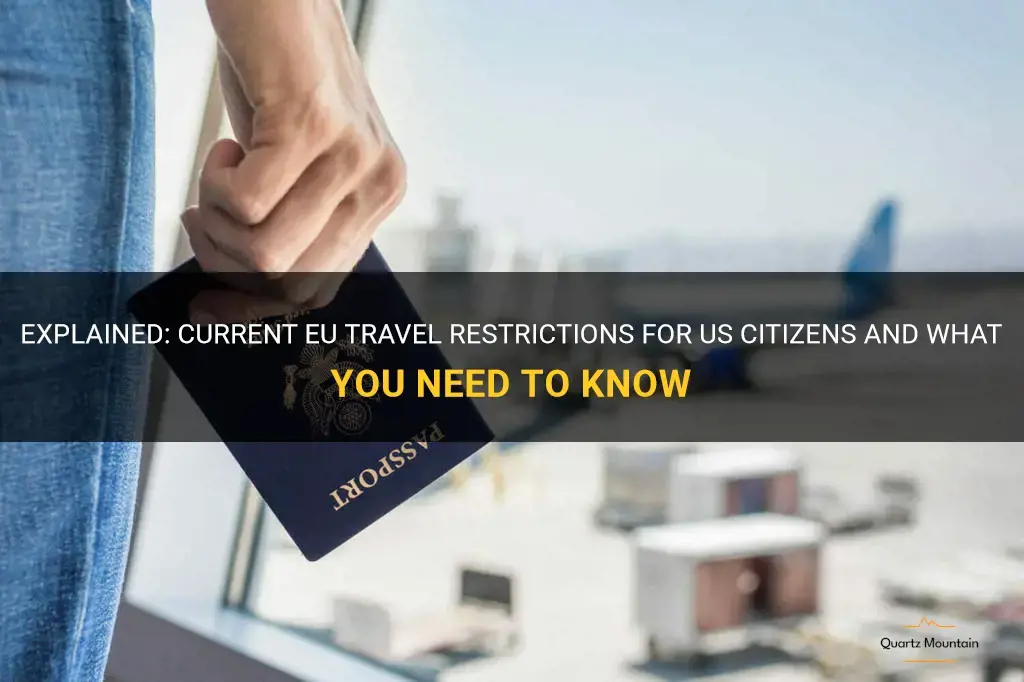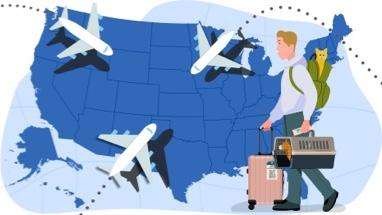New requirements for Americans traveling to Europe postponed until 2025
Visitors who now travel visa-free will need to get approval prior to departure.
Americans eyed upcoming travel to European destinations slightly differently due to news of a requirement that was set to start in 2024 for U.S. passport holders. But now, EU officials have postponed the European Travel Information and Authorisation System ( ETIAS ) launch until spring of 2025.
SchengenVisaInfo.com, a website dedicated to the world's largest visa-free zone where 27 European countries abolished their internal borders known as the Schengen Area, first reported that an EU official confirmed ETIAS won't go live until May 2025, "due to continued delays with the introduction of the related Entry-Exit System (EES), which needs to be operational before ETIAS can be implemented."
An official for the European Union did not immediately respond to ABC News' request for comment.

What to know about ETIAS for US travelers
If you previously traveled to Europe without a visa, you will now need to apply for authorization through the ETIAS , before visiting.

Today, American travelers have visa-free access to 184 global destinations, according to the Henley Passport Index . And while the U.S. passport is currently ranked eighth-most powerful passport to own, that could be set to shift when the European Union adds its new documentation requirements for U.S. visitors.
The application form, which will be available on the official ETIAS website as well as a mobile application, has a fee of 7 euros or $7.79 U.S. dollars. All communication is done by email.
Once you are approved for travel, the authorization entitles visitors to stay in European countries that require ETIAS for up to 90 days within any 180-day period and travelers must be in possession of a valid ETIAS during their entire stay.
MORE: New warning issued for rebooking air travel after delays, cancellations
According to ETIAS, most applications should be processed within minutes, but in case an application takes longer, decisions will be sent within four days or up to 14 days if the applicant is asked to provide additional documentation.
The European Union encourages travelers to apply for an ETIAS authorization "well in advance of your planned journey."
Related Stories

James, Jennifer Crumbley sentenced to 10-15 years
- Apr 9, 1:13 PM

Dead baby on highway linked to murder-suicide
- Apr 9, 6:15 PM

4.8 magnitude earthquake rocks Northeast
- Apr 6, 2:30 PM
Confirmation of application submission will be sent on email with a unique number that is needed for future reference.

Upon receiving ETIAS travel authorization, travelers are to ensure that their name, passport number and other information is correct because any mistake will prevent them from crossing the border.
If an application is refused, the email will include the reasons for the decision along with information about how to appeal.
ETIAS travel authorization is valid for three years, according to the EU, or until the travel document you used in your application expires, whichever comes first.
MORE: European heat wave breaking records with little relief in sight
The ETIAS authorization is linked to a person's travel document -- such as a U.S. passport -- and both documents will be needed to board a flight, bus or ship to enter any of the European countries that require ETIAS.
Similar to international border requirements with a passport, the ETIAS authorization doesn't guarantee automatic right of entry. "Border guards will verify that you meet the entry conditions" and anyone who does not meet the conditions "will be refused entry," according to the EU.
Click here to learn more about the process from the European Union.
An earlier version of this story was originally published on July 21, 2023.
Related Topics

Body of 3rd Key Bridge victim recovered
- Apr 9, 10:48 AM

Judge denies Trump's attempt to delay trial
- Apr 8, 5:46 PM
Welcome page

System for registering non-EU nationals travelling for a short stay in 29 European countries (starting in the second half of 2024)

Travel authorisation for visa-exempt travellers to enter 30 European countries (starting in mid-2025)
Share this page
- Skip to main content
- Keyboard shortcuts for audio player
Wait, do you need a visa to go to Europe now? The new ETIAS requirements, explained
Emily Olson

St. Mark's basilica in Venice is one place U.S. passport holders may not be able to get to without approval under the new ETIAS requirements Andrea Pattaro/AFP via Getty Images hide caption
St. Mark's basilica in Venice is one place U.S. passport holders may not be able to get to without approval under the new ETIAS requirements
Already thinking about next summer's vacation plans? If Europe is on your short list, there could be one extra step to take before boarding that plane.
Starting in 2024, American passport holders traveling to 30 European countries will need authorization via the European Travel Information and Authorization System (ETIAS).
Though it may sound complicated, the ETIAS and the reasoning behind it are quite similar to existing travel requirements and reflect increasing fear of terrorism in the U.S., Europe and around the world.
Here's what you need to know.
What is ETIAS? Is it a visa?
While some media outlets are taking a cue from the European Union's travel site and calling this a visa, in truth, ETIAS is more like a travel authorization form.

Summer air travel could be expensive and chaotic. Here's how to avoid trouble
"It's definitely not a visa," said Dan Hamilton, a senior non-resident fellow for foreign policy at the Brookings Institution. "It's an electronic entry-point, an authorization for countries that are currently visa-free."
Even the European Commission has said as much (and in bold letters) , writing this is "not a visa" but rather an "automated IT system" in a press release on the discussions around it back in 2018.
Whatever you want to call it, the ETIAS form is not what you'd seek if you're trying to work or live in Europe, but rather what you'll need for short-term trips — up to 90 days within any 180-day period.
Why is it being implemented?
These new requirements have been years in the making, stemming back to a rise in terrorism fears following 9/11. It's very similar to the Electronic System for Travel Authorization — or ESTA — program that the U.S. implemented in 2008 .
At the heart of ETIAS is an electronic database system to better track who's coming and going. According to the EU's latest report on terrorism data , EU law enforcement authorities arrested about 388 suspects for terror-related offenses in 2021, more than half of whom were accused of being associated with Jihadist groups based abroad.
The European Commission says ETIAS may have the added impact of cutting down on "irregular migration" (i.e. illegal immigration), but one thing the form is definitely not aimed to do is deter tourism in general.

'Revenge travel' is surging. Here's what you need to know
Crowded cities, inflated airfare and extreme heat disasters may all be making headlines this summer, but many of these European countries are still depending on tourism revenue to help them bounce back from pandemic slumps, Hamilton said.
And the pandemic is another one of the many reasons this new requirement has been delayed by decades — there was no need for ETIAS when countries closed their borders to all travel amid fears of spreading COVID-19.
"Another part of it is simply the pace of the way this parliament and European commission works," Hamilton explained in an interview with NPR. "They're ending their term and pushing through a lot of these directives because parliamentary elections happen next June."
"And getting 30 countries to agree on anything takes a long time," he added.
When does it take effect?
The European Union's website says the new authorization will start in 2024 but hasn't clarified a specific date. A press spokesperson for the union's travel arm did not respond to NPR's request for information.
And, similarly, a spokesperson for the State Department told NPR that the U.S. government website for international travel (travel.state.gov) would be updated "once the regulation goes into effect," but didn't specify when that would be.
"Frankly, I'd be surprised if this starts on time," Hamilton said. The rollout of ETIAS has already been delayed at least once.
But it couldn't hurt to plan ahead for any 2024 travel just to be safe.
Who needs to apply for ETIAS approval?
Basically, all passport holders from 60 countries who can currently travel to most European destinations without a visa — and that includes American passport holders — will now need to get ETIAS authorization for the same trip. That's about 1.4 billion people, by the European Union's estimation.
There are 30 European countries in total on the impacted destination list , including those in the "Schengen Area" — 27 European countries, many that are part of the European Union, that agreed to ease border restrictions to facilitate the movement of people within Europe.

Planning a trip? Here's how to pack like a pro
Those Schengen countries include top vacation spots like France, Italy and Spain.
The other three countries on the list are Romania, Bulgaria and Cyprus, which are all trying to become a part of the Schengen Area soon.
You can check the full list of both impacted passport holders and affected European destinations here.
How can you apply for ETIAS approval (and does it cost money)?
The application isn't open yet, but the European Union says that when it is, all necessary forms can be filled out via a web portal or mobile phone application.
You'll be asked to share personal information such as your date of birth, parents' names and details about your current occupation and previous criminal convictions. You'll also need to share a passport that is not set to expire in less than three months.
Oh, and you'll have to pay a fee of 7 euros (about $8).
When is the right time to apply?
If you want to play it safe, apply well in advance of your trip — no later than a month out.
ETIAS says most applications "are processed within minutes" and decisions are delivered within four days. But that wait could take up to 14 days if you are requested to supply additional information and up to 30 days if you're invited to interview.

It's Been a Minute
Presenting 'life kit': making the most of travel and your time off.
Those denied an application can appeal, but that process could be even lengthier.
The European Union says ETIAS approval will stay valid for three years or until the passport you used in your application expires.
Naturally, you'll also need to follow the ETIAS rules to stay in good standing.
Those with ETIAS approval can stay in the European countries on the list for up to 90 days within any 180-day period. So you can leave and come back, but you can't stay in the confines of the countries on the list for 91 days or more non-stop.
What happens if I don't apply for this and try to travel to Europe?
Your ETIAS approval will be linked to your passport. So without it, airport security (or cruise, bus or train line staff) won't let you board.
In other words, you can kiss that dream vacation goodbye.
- European Commission
- Europe travel
- European Union
- Global Passport Index
- Partner With Us
- Antigua and Barbuda
- St Kitts and Nevis
- United States
- Portugal Golden Visa
- Spain Golden Visa
- Cyprus Golden Visa
- Malta Golden Visa
- Greece Golden Visa
- Canada Start-Up Visa
- ANTIGUA AND BARBUDA Citizenship by Investment
- Grenada Citizenship by Investment
- Dominica citizenship by investment
- St Lucia citizenship by investment
- St Kitts and Nevis citizenship by investment
- Malta citizenship by investment
- Turkey citizenship by investment
- Curaçao citizenship by investment
- Vanuatu citizenship by investment
- Property Investment
Americans Traveling to Europe: A Complete Guide
Updated: March 5, 2024
Home » Europe » Americans Traveling to Europe: A Complete Guide
Do US citizens need an EU visa to enter Europe?
During stays of up to 90 days within 180 days, US residents do not require a visa to enter the Schengen Area in Europe , allowing you to travel to 27 countries. Nonetheless, US nationals must still fulfill some entry criteria to enter the Schengen Area, such as holding a valid passport, a return ticket, proof of adequate finances, and travel insurance .
Residents of the United States who are nationals of a country with which the EU has established a visa-free system may enter the Schengen countries.
Conversely, US residents who are not nationals of a visa-free country and plan to visit the Schengen countries for tourism or business for up to 90 days in 180 days will need to apply for a Schengen Visa in advance.
Beginning in 2024, US residents will be required to have an ETIAS (European Travel Information and Authorization System) to enter Europe. However, an ETIAS is not a visa. You only need to apply once every three years as the ETIAS authorization will be valid for three years or until the traveler’s passport expires, whichever comes first.
The ETIAS will keep track of who enters and exits the Schengen Area. It acts in a similar way to the US ESTA (Electronic System For Travel Authorization) .
Austria, Belgium, Bulgaria, Croatia, Cyprus, Czechia, Denmark, Estonia, Finland, France, Germany, Greece, Hungary, Iceland, Italy, Latvia, Liechtenstein, Lithuania, Luxembourg, Malta, the Netherlands, Norway, Poland, Portugal, Romania, Slovakia, Slovenia, Spain, Sweden, and Switzerland can be accessed through an ETIAS.
As a result, beginning in 2024, US residents may require an ETIAS to visit the following European microstates with open borders: Monaco (through France), San Marino (via Italy), and Vatican City (via Italy). It will let tourists enter and depart the Schengen Area as often as they like during the approved period, as long as no stay exceeds 90 days in 180 days.

What documents do Americans need to enter the Schengen Area?
It is crucial to know that numerous sorts of visas are available for various purposes (such as job, study, or long-term visits), and each visa has its own set of requirements and provisions. When flying to Europe, travelers should always check the most up-to-date information on visa requirements and procedures. Despite the fact that Americans visiting Europe do not require a visa , they must meet specific standards to enter the European Union.
Valid passport : Your passport must be valid for at least three months beyond the day you want to leave the Schengen Area.
Accommodation proof : You may be required to give evidence of where you will be staying during your trip, such as hotel bookings or a letter of invitation from a host.
Proof of funds : You may be required to submit proof that you have enough money to sustain yourself throughout your trip, such as a bank statement.
Evidence of further travel : You may be required to present proof of onward travel, such as a return airline or train ticket.
Travel insurance : It is strongly advised that you get travel insurance that covers medical emergencies, trip cancellation, and other unforeseen events.
It’s worth noting that these criteria may differ significantly based on the nation you’re going and the purpose of your trip. For the most up-to-date information on entrance requirements, always contact the embassy or consulate of the country you will be visiting.
Which EU nations can Americans travel to without a visa?
Americans can visit the following 27 EU countries without an EU tourist visa for stays up to 90 days within 180 days:
- Czech Republic
- Liechtenstein
- Netherlands
- Switzerland
We recommend referring to the most updated information on the government website on entry restrictions for the country you are traveling to, as they are subject to change.
Can a US citizen stay in Europe for more than 90 days?
Generally, US residents are not allowed to stay in Europe’s Schengen Zone for more than 90 days in a 180 day period without a visa. This law applies to all Schengen Area nations, even those not European Union members.
There are, however, certain exceptions to this rule. If you hold a study or work visa, for example, you may be permitted to stay in the Schengen Area for the period of your visa.

Furthermore, certain European nations not part of the Schengen Area may have alternative visa requirements, enabling US residents to remain for extended periods. For example, the United Kingdom enables US citizens to stay without a visa for up to six months .
Overstaying your allowed days always has repercussions, like penalties or deportation, even if the deviation from the 90/180 rule is inadvertent.
Is travel health insurance mandatory for US nationals visiting Europe?
Travel health insurance is not required for US citizens visiting Europe, although it is strongly advised. Obtaining a Schengen Visa requires the applicant to produce proof of travel insurance with a minimum coverage of €30,000 for medical expenditures, including repatriation.
Although you are not obliged to get travel insurance, having coverage in case of unanticipated medical crises, trip cancellations, or other unforeseen occurrences is a smart idea.
How do I get travel insurance for Europe from the USA?
You may obtain travel insurance for Europe from the United States by purchasing a policy from a travel insurance company. Allianz, Travel Guard, and World Nomads are three prominent travel insurance firms in the United States. You may compare plans and prices online and select the best fit for your requirements and budget.
Before selecting travel insurance coverage, study the terms and conditions thoroughly to understand what is and is not covered. Certain insurance may have restrictions or limitations, so selecting a policy that covers your travel needs is critical.

Can a US citizen be rejected from entering Europe visa-free?
While it is uncommon for US citizens to be denied visa-free admission into Europe, it can occur if visa-free visitors do not fulfill the entry requirements or if border authorities have concerns about the traveler’s intentions. Some of the most prevalent causes of rejection are:
Inadequate paperwork : If a traveler cannot present sufficient proof to substantiate the purpose of their trip or their capacity to support themselves during their stay financially, they may be denied admission.
Criminal history : If a traveler has a criminal history, particularly for acts such as drug trafficking or terrorism, they may be denied entrance.
Prior overstay : The passenger may be denied admission if they have previously overstayed their visa or breached immigration regulations in the Schengen Area or other countries.
Suspicion of unlawful activity : If border officers suspect that the passenger is entering the Schengen Area for illicit purposes, such as working without a formal visa or engaging in human trafficking, they may deny entrance.
If a US citizen is refused admission into Europe, they may be detained until a trip back to the US can be arranged.
Travel Tips for Americans visiting Europe
Europe is a fascinating continent with a rich history, stunning architecture, various cultures, and delectable cuisine. Here we provide some essential travel advice for Americans traveling Europe to keep in mind to guarantee a smooth and pleasurable vacation.
Off-season travel
Traveling during the off-season is one of the best ways to save money and avoid congestion. This commonly occurs from November through March, barring vacations. Flights and lodging are often less expensive during this period, and you have a higher chance of obtaining available tickets to significant sites.
Utilize low-cost airlines
There are a lot of low-cost airlines in Europe that may save you a significant amount of money on tickets. Ryanair, EasyJet, and Wizz Air are some of the most popular low-cost carriers. These airlines charge extra for luggage, seat selection, and other perks. Booking your travel tickets well in advance can provide significantly cheap fares for your travel destinations.
Befriend locals
Don’t be scared to strike up a conversation with locals; Europeans are often polite and open to visitors. They can provide valuable insights into local culture, food, and hidden jewels that guidebooks may not provide.
Book in advance
Famous European sites and restaurants may rapidly fill up, especially during peak season. To avoid disappointment, book reservations for popular attractions and restaurants in advance.
Carry cash with you
While credit cards are generally accepted in Europe, keeping some cash on hand for minor purchases and transactions is a brilliant idea. To avoid fraud, only exchange your money at a reputed exchange office.
The Euro is not the currency for every country in Europe
While the Euro is Europe’s most widely used currency, it is not used in all nations. The British Pound is used in the United Kingdom, the Swiss Franc is used in Switzerland, and certain Eastern European countries use their currency. Learn about the currencies used in the countries you intend to visit and exchange your money correctly.
Carry an umbrella
Even in the summer, the weather in Europe may be unpredictable, so bring an umbrella or raincoat with you.
Learn some local language
A few simple words in the local language might help you make a good impression and get by in a new nation. “Hello,” “please,” “thank you,” “pardon me,” and “where is the bathroom?” are some essential words to learn.
Watch out for pickpockets
Pickpocketing can be an issue in certain prominent European tourist spots, so be aware of your surroundings and take measures. Keep your valuables near you, avoid carrying large quantities of cash, and avoid distractions or crowds.
Proper attire
Europeans dress more formally than Americans, so bring some dressier attire for dining out or visiting cultural events. Also, many churches and other religious sites have dress regulations that require modest apparel, so plan accordingly.
Understand the local laws and traditions
Each European nation has its unique set of laws and customs, so do your homework before you travel. In certain nations, for example, it is prohibited to jaywalk or consume alcohol in public, and in others, giving a modest tip at restaurants is customary.
Touring Europe may be a fantastic experience if you wish to travel abroad, but you must be prepared and knowledgeable. Following these travel suggestions will help you make the most of your vacation while avoiding typical pitfalls to enjoy everything when you visit Europe.
Americans traveling to Europe may have a safe, fun, and memorable experience. All European countries have something for everyone, whether you want to see the ancient sights of Rome, the meandering canals of Venice, or the breathtaking landscapes of Scotland. So pack your luggage and prepare for an unforgettable experience! Have a safe journey!

Frequently Asked Questions about Americans Travelling to Europe
Are americans allowed to travel to europe.
Yes, of course, Americans are permitted to visit Europe .
What do Americans need to do to travel to Europe?
To go to Europe as an American , you’ll need a valid passport and a visa depending on the duration and purpose of your trip. Moreover, to enter several European nations, a negative COVID-19 test result or confirmation of immunization may be required.
Do you need COVID vaccine to travel to Europe?
Regarding COVID-19 vaccine requirements, each European country has its own, so verify the exact regulations of the country you want to visit before planning your trip. Some nations may demand vaccination evidence, while others may require a negative COVID-19 test result or a mix of the two, and some nations may not have any strict regulations anymore.

- Antigua and Barbuda Citizenship
- Grenada Citizenship
- Dominica Citizenship
- St Lucia Citizenship
- St Kitts and Nevis Citizenship
- Malta Citizenship
- Turkey Citizenship
- Curaçao Citizenship
- Vanuatu Citizenship
- Canada Start-up Visa

U.S. Citizens Will Need to Register and Pay a Fee to Travel to Europe—Here’s When and What to Know
The launch of europe’s new etias travel authorization program has been delayed yet again. here’s what travelers need to know for when it finally goes into effect..
- Copy Link copied

France is among the more than two dozen Schengen countries in Europe that will (eventually) have new entry rules.
Photo by Chan Lee/Unsplash
Europe is the most visited region in the world and has always been a very popular destination for U.S. travelers. After pandemic travel restrictions were dropped across Europe in 2022 and now that U.S. citizens are plotting future journeys to the continent once again, they should be aware that the rules for entry into the European Schengen Zone will soon change.
Initially meant to come into effect on January 1, 2021 and then delayed (again and again) until 2024, the European Travel Information and Authorization System ( ETIAS ) is now slated to launch sometime in 2025 (more on the actual launch date below). At that point, all U.S. citizens who want to travel to the 27 member countries of Europe’s Schengen Zone will need to register with ETIAS or risk being turned away at the border.
Here’s everything you need to know about the new ETIAS process.
Why are the requirements for entering Europe changing?
The European Union decided to implement this new travel authorization program to protect and strengthen its borders amid mounting terror threats in Europe. By requiring visitors to register, the hope is that the EU will be able to identify any possible threats or risks associated with travelers coming into the participating countries before they arrive.
Which European nations will require ETIAS authorization to visit?
The new travel authorization applies to those entering any member country of Europe’s Schengen Zone. Currently, that includes 23 countries that are also members of the European Union, four non-EU countries, plus three European micro-states. That means that you’ll need to register to enter:
- Czech Republic
- Liechtenstein
- Netherlands
- Switzerland
- Vatican City
While Romania and Bulgaria aren’t currently Schengen countries, they are in the process of joining and will be subject to the same requirements once they do. However, there are still many European nations that aren’t part of the Schengen Zone, mostly in Eastern Europe. That means you’ll be able to travel to Albania, Andorra, Armenia, Azerbaijan, Belarus, Bosnia and Herzegovina, Cyprus, Georgia, Kosovo, Macedonia, Moldova, Montenegro, Serbia, Türkiye, and Ukraine without an ETIAS registration.
Who will need to obtain ETIAS authorization?
American citizens, as well as travelers from 60 other countries, will require an ETIAS visa waiver to travel to any of the Schengen-zone countries for short stays once the ETIAS program goes into effect. The list of ETIAS-eligible countries includes Canada, Mexico, Australia, and many more. All travelers, regardless of their age, will need their own ETIAS approval in order to travel to Europe’s Schengen Zone countries.
How will travelers apply for ETIAS?
Once the ETIAS application is available online, it should only take about 10 minutes to fill out, according to ETIAS.com, the landing page for news and information regarding the new travel authorization process. To apply, you’ll need a valid passport , an email address, and a debit or credit card to pay the nonrefundable 7-euro application fee, which applies to individuals between the ages of 18 and 70. Those under the age of 18 or over 70 still need to have an ETIAS but will not be charged.
How much will it cost to enter Europe?
To obtain an ETIAS registration, there will be a required, nonrefundable application fee of 7 euros (US$7.43, based on conversion rates at time of publication). Only travelers who are younger than 18 years old or older than 70 years old will be exempt from the fee (though the will still need to have ETIAS approval). There are no other fees associated with the program.
How long will the authorization process take?
After you fill out your application online with the personal information on your passport and answer a series of security and health-related questions, your ETIAS application will be processed immediately, and you will receive an email confirming that your ETIAS has been approved within 96 hours.
“A small percentage of applications may take up to four weeks to process if additional documentation is required from the applicant. If your ETIAS has not yet been approved and you do not have any other travel authorization, you will not be able to enter a country within the European Union,” according to the ETIAS website .
Will you have to reapply for each trip to Europe?
No, you will not need to reapply after each trip to Europe. After you apply for the first time, your ETIAS authorization will be valid for three years—or until your passport expires , whichever comes first. Because the ETIAS is valid for short-term stays of up to 90 days for both leisure and business travelers, you’ll be able to re-enter Europe multiple times within that three-year period without renewing it, as long as your stay doesn’t exceed 90 days within a 180-day period. Those who want to study or work in Europe will need to apply for a proper work or study visa.
Does this mean I will need a visa to travel to Europe?
ETIAS is not a visa; it’s a travel authorization requirement for visa-free visitors , similar to the U.S. Electronic System for Travel Authorization (ESTA) .
The new entry requirement “is more accurately referred to as a visa-waiver. The ETIAS, like the ESTA, is a travel authorization for travelers not requiring a visa to visit Europe. Under the ETIAS, these visitors will undergo additional security checks prior to being permitted to enter the EU. The ETIAS will be mandatory for citizens of such countries as the United States, Australia, New Zealand and Canada,” states ETIAS.com .
In other words, ETIAS will only pre-screen travelers who do not need a Schengen visa.
“An ETIAS travel authorization does not reintroduce visa-like obligations,” according to a fact sheet provided by the European Commission . “There is no need to go to a consulate to make an application, no biometric data is collected and significantly less information is gathered than during a visa application procedure.”
Why was the launch of ETIAS delayed?
Initially meant to come into effect on January 1, 2021, the ETIAS was first delayed until January 1, 2023, and then again (a few more times) until 2024. It is now slated to enter into operation in 2025, due to delays in the anticipated adoption of the ETIAS regulation plus the fact that ETIAS is being developed closely with the Entry/Exit System (EES). The EES was scheduled to launch in May 2023, but it has been pushed back until 2024. The EES is an electronic system that will keep track of visitors as they cross borders, and its installation is a precondition for ETIAS to enter into operation.
When exactly will ETIAS go into effect?
In October 2023, the European Commission presented an updated timeline for the launch of Europe’s new tech-driven Entry/Exit System (EES), which will keep track of visitors as they cross borders, and for Europe’s ETIAS travel authorization program. The new ETIAS travel entry requirement is now scheduled to launch in mid-2025 , following the establishment of Europe’s new tech-driven EES that is slated to go into effect in the fall of 2024, according to the Commission.
Once ETIAS goes into effect in 2025, a transitional period of six months will follow. During that time frame, the countries requiring the travel authorization will have to inform travelers of the new regulations. They will still be allowed to cross borders during that six-month period without the ETIAS. The six-month transitional period will be followed by a grace period, the length of which has not yet been determined. During the grace period, the ETIAS requirement will apply unless it’s a traveler’s first time entering Europe since the end of the transitional period.
This article was originally published in 2019. It was most recently updated on November 2, 2023, to include current information.

Awesome, you're subscribed!
Thanks for subscribing! Look out for your first newsletter in your inbox soon!
The best things in life are free.
Sign up for our email to enjoy your city without spending a thing (as well as some options when you’re feeling flush).
Déjà vu! We already have this email. Try another?
By entering your email address you agree to our Terms of Use and Privacy Policy and consent to receive emails from Time Out about news, events, offers and partner promotions.
- Things to Do
- Food & Drink
- Time Out Market
- Coca-Cola Foodmarks
- Los Angeles
Get us in your inbox
🙌 Awesome, you're subscribed!

Starting 2023, U.S. citizens will have to register to travel to Europe
The European Travel Information and Authorization System (ETIAS) is going into effect at the end of 2022.

In an effort to thwart potential threats, the European Union is going ahead with its new European Travel Information and Authorization System (ETIAS), by which folks coming from the United States and another 60 countries (including Canada, Mexico and Australia, among others) will have to register before entering the various destinations that make up Europe's Schengen Zone.
Currently, the Schengen Zone is comprised of 22 countries that are also part of the European Union, plus four non-EU ones and three European micro-states. Here is the list of countries that will require you to register prior to entering: Austria, Belgium, Czech Republic, Denmark, Estonia, Finland, France, Germany, Greece, Hungary, Iceland, Italy, Latvia, Liechtenstein, Lithuania, Luxembourg, Malta, Netherlands, Norway, Poland, Portugal, Slovakia, Slovenia, Spain, Sweden, and Switzerland. San Marino, Vatican City and Monaco, three micro-states, are also part of that list. As of now, Romania, Bulgaria, Croatia and Cyprus are in the process of joining the Schengen Zone and will therefore require authorization prior to arrival as well.
The new system was originally set to go into effect on January 1, 2021, but will now kick off at the end of 2022 and won't be mandatory for at least six months after that. During those six months, travelers can expect to be reminded about the need for a valid travel authorization in upcoming months.
Lest you think of the process as a visa-like one, think again. "An ETIAS travel authorization does not re-introduce visa-like obligations," reads a 2018 fact sheet released by the European Commission . "There is no need to go to a consulate to make an application, no biometric data is collected and significantly less information is gathered than during a visa application procedure. Whereas, as a general rule, a Schengen visa procedure can take up to 15 days, and can in some cases be extended up to 30 or 60 days, the online ETIAS application only takes a few minutes to fill in." Once approved, the application will be valid for three years and an unlimited number of entries.
As for how the application will actually work: you'll need an email address, a valid passport and a credit card to pay the €7 (about $8 US) application fee, which can be completed online. You'll get an approval email a few hours after submitting your document. Although kids under the age of 18 will also have to fill out an application, they will not be charged a fee for doing so.
Most popular on Time Out
- The entire McDonald's breakfast menu, ranked - Candy maker Mars Wrigley swoops in with trick or treating app for Halloween - The scariest real-life haunted houses in the U.S. - 11 Starbucks secret menu items and how to order them - Starting this weekend, you can send Taco Bell to friends with the push of a button
- Anna Rahmanan
Share the story
An email you’ll actually love
Discover Time Out original video
- Press office
- Investor relations
- Work for Time Out
- Editorial guidelines
- Privacy notice
- Do not sell my information
- Cookie policy
- Accessibility statement
- Terms of use
- Copyright agent
- Modern slavery statement
- Manage cookies
- Advertising
Time Out products
- Time Out Worldwide
Přejít k obsahu | Přejít k hlavnímu menu | Přejít k vyhledávání

- New EU travel rules for US citizens coming in 2024
- < Travel news
Travel news
By David Szmidt August 2, 2023
By David Szmidt | August 2, 2023
Entry to the European Union is changing for people from the United States starting next year. What are the new ETIAS rules, when do they come into force, and how will they affect you and where you can travel?
New European travel rules being implemented next year will affect visitors from 60 countries, including the US. There are currently 1.4 billion people in those 60 countries that can visit the 30 European nations to which the new rules will apply , so this regulation will add an extra step for a significant number of incoming travelers. But what are they, and what do you have to know? We answer all your questions.
What’s the new system called?

The new entry system is called the European Travel Information and Authorization System, or ETIAS for short. It’s basically a version of the Electronic System for Travel Authorization — or ESTA — program that the US brought in in 2008.
Is the ETIAS a visa?
No. The European Commission was very clear on this when the system was announced back in 2018, stating it was “not a visa” but rather an “automated IT system”. It’s essentially an electronic checkpoint — one last piece of authorization before travelers can enter a part of the world that’s currently visa-free.
Why do I need ETIAS?
Travelers will need to complete an ETIAS form if they want to visit Europe. It’s not for work or permanent relocation purposes, but rather what you’ll need for short-term trips — up to 90 days within any 180-day period.
Which countries in Europe will require ETIAS?
The countries affected include big tourist destinations such as Italy , France, and Spain . In total, there are 30 countries — 27 that are part of the Schengen free movement area, and Romania, Bulgaria and Cyprus, which hope to become part of Schengen soon. You can see the full list of affected countries and impacted passport holders here .
How do I apply for ETIAS approval? Does it cost money?
As mentioned above, it’s similar to the US system. You’ll need to provide details about yourself (passport number, address, occupation etc.), pay a nominal fee of €7, and you’re good for up to three years of coming and going — or until your passport expires, if that’s sooner. It’ll be available either through a dedicated web portal or on an app.
When should I apply?
Our advice is not to leave it later than a month before your trip. Although ETIAS says most applications “are processed within minutes” and decisions are delivered within four days, if you’re required to provide additional information, that period could increase to 14 days, and if you need to interview, be prepared to wait for up to a month for the decision. When you’re approved, you can visit the area for up to 90 days within any 180-day period. So you can leave and come back, but you can’t overstay your welcome.
What happens if I don’t have ETIAS approval?
You won’t be able to travel. Your ETIAS approval will be linked to your passport, so if you have one without the other, you’ll be denied entry to the area.
Why is the ETIAS being implemented?
It’s an electronic database to track movements in and out of the continent. Similar to the US system, the intention was to track people suspected of planning terror attacks; the reason it’s been so long in the making is that, according to Dan Hamilton, a senior non-resident fellow for foreign policy at the Brookings Institution in an interview with NPR , “it is simply the pace of the way this parliament and European Commission works. It was delayed by the pandemic as well when countries closed their borders anyway, and simply getting 30 countries to agree on anything takes a long time.”
A by-product of the implementation of the system may be less “irregular migration” (what the European Commission calls illegal immigration), but what it’s absolutely not intended to do is deter tourists. Many countries are still dependent on tourism to alleviate any lingering effects of the pandemic-affected years, and are happily welcoming travelers back as such.
In short, ETIAS is simply a mildly inconvenient hoop to jump through while traveling. UK and EU citizens have been doing something similar since 2008 and it hasn’t affected or deterred tourism to the US. Just make sure you read up on the rules before traveling, and you can happily start making plans for your next trip with Kiwi.com .
Do you want more travel news, hacks and inspiration? Visit Kiwi.com Stories .
Europe United States US
Popular routes on Kiwi.com
- Cheap flights from Dubai to London
- Cheap flights from Vilnius to Tenerife
- Cheap flights from Nairobi to Eldoret
- Cheap flights from Tenerife to Vilnius
- Cheap flights from London to Prague
- Cheap flights from Barcelona to Tenerife
- Cheap flights from London to Athens
- Cheap flights from Cairo to Dubai
- Cheap flights from Berlin to Istanbul
- Cheap flights from Istanbul to Baku
- Cheap flights from London to Warsaw
- Cheap flights from London to Lisbon

5 destinations to visit when you’re young and broke
Where are some of the best places to travel to if you’re young and on a budget? We’ve looked at some Gen Z travel habits and picked five of the cheapest and most inspiring destinations in Europe and Asia

World Travel Hackers: Students save over €7,000 on an Asian backpacking trip
Get top travel money tips, find out how to get the most out of long layovers, and learn how two of our World Travel Hackers spent less than €2,000 each on a four-week adventure in Asia

The best countries from which to see the northern lights in 2024
Here’s our list of the top places to see the aurora borealis — the northern lights. We’ve got answers to the most common questions, locations with the best chances to see the lights, and easy ways to see the lights in Europe and North America

Cluj-International Airport: An all-inCLUJive experience in Romania’s second city
Browse Kiwi.com's deals on cheap flights to Cluj-Napoca International Airport, and find out here exactly why Romania's second city is worth visiting, from a fascinating history to world-renowned music festivals

Where to go in 2024: the best destinations, hidden gems, and top travel trends
Where should you travel in 2024? We take a look at the most popular destinations, trending cities and a couple of lesser-visited places, as well as examine future travel trends and touch on where you might want to avoid next year

World Travel Hackers: The BEST protection from flight cancellations
When one of our World Travel Hacker duos experienced a flight cancellation, the Kiwi.com Guarantee came to the rescue. Read about this and get more budget travel tips here

David Szmidt
David is a lead writer for Kiwi.com, as well as a football-watcher, music-listener and beer-appreciater. @UtterBlether

Paris on a Budget: 10 Ways to Save Money When You Visit

Los Angeles on a budget: 10 ways to save money when you visit

Take the stress out of travel: World Travel Hackers on insurance from Kiwi.com and AXA travel insurance
An official website of the United States government
Here’s how you know
Official websites use .gov A .gov website belongs to an official government organization in the United States.
Secure .gov websites use HTTPS A lock ( Lock Locked padlock icon ) or https:// means you’ve safely connected to the .gov website. Share sensitive information only on official, secure websites.

Visas for U.S. citizens traveling abroad
If you are a U.S. citizen planning to travel abroad, you may need a visa to enter a foreign country. Learn how to find your destination's visa requirements.
While not all countries require visas for American travelers, many do. Look up your destination using the U.S. State Department's Learn About Your Destination search tool . On the country’s information page, you will find entry, exit, and visa requirements. You will also find travel advisories and a link to the country’s embassy.
LAST UPDATED: December 6, 2023
Have a question?
Ask a real person any government-related question for free. They will get you the answer or let you know where to find it.

An official website of the United States government
Here’s how you know
Official websites use .gov A .gov website belongs to an official government organization in the United States.
Secure .gov websites use HTTPS A lock ( Lock A locked padlock ) or https:// means you’ve safely connected to the .gov website. Share sensitive information only on official, secure websites.
- Fact Sheets
Frequently Asked Questions: Guidance for Travelers to Enter the U.S.
Updated Date: April 21, 2022
Since January 22, 2022, DHS has required non-U.S. individuals seeking to enter the United States via land ports of entry and ferry terminals at the U.S.-Mexico and U.S.-Canada borders to be fully vaccinated for COVID-19 and provide proof of vaccination upon request. On April 21, 2022, DHS announced that it would extend these requirements. In determining whether and when to rescind this order, DHS anticipates that it will take account of whether the vaccination requirement for non-U.S. air travelers remains in place.
These requirements apply to non-U.S. individuals who are traveling for essential or non-essential reasons. They do not apply to U.S. citizens, Lawful Permanent Residents, or U.S. nationals.
Effective November 8, 2021, new air travel requirements applied to many noncitizens who are visiting the United States temporarily. These travelers are also required to show proof of COVID-19 vaccination. All air travelers, including U.S. persons, must test negative for COVID-19 prior to departure. Limited exceptions apply. See CDC guidance for more details regarding air travel requirements.
Below is more information about what to know before you go, and answers to Frequently Asked Questions about cross-border travel.
Entering the U.S. Through a Land Port of Entry or Ferry Terminal
Q. what are the requirements for travelers entering the united states through land poes.
A: Before embarking on a trip to the United States, non-U.S. travelers should be prepared for the following:
- Possess proof of an approved COVID-19 vaccination as outlined on the CDC website.
- During border inspection, verbally attest to their COVID-19 vaccination status.
- Bring a Western Hemisphere Travel Initiative compliant border crossing document, such as a valid passport (and visa if required), Trusted Traveler Program card, a Department of State-issued Border Crossing Card, Enhanced Driver’s License or Enhanced Tribal Card when entering the country. Travelers (including U.S. citizens) should be prepared to present the WHTI-compliant document and any other documents requested by the CBP officer.
Q. What are the requirements to enter the United States for children under the age of 18 who can't be vaccinated?
A: Children under 18 years of age are excepted from the vaccination requirement at land and ferry POEs.
Q: Which vaccines/combination of vaccines will be accepted?
A: Per CDC guidelines, all Food and Drug Administration (FDA) approved and authorized vaccines, as well as all vaccines that have an Emergency Use Listing (EUL) from the World Health Organization (WHO), will be accepted.
Accepted Vaccines:
- More details are available in CDC guidance here .
- 2 weeks (14 days) after your dose of an accepted single-dose COVID-19 vaccine;
- 2 weeks (14 days) after your second dose of an accepted 2-dose series;
- 2 weeks (14 days) after you received the full series of an accepted COVID-19 vaccine (not placebo) in a clinical trial;
- 2 weeks (14 days) after you received 2 doses of any “mix-and-match” combination of accepted COVID-19 vaccines administered at least 17 days apart.
Q. Is the United States requiring travelers to have a booster dose to be considered fully vaccinated for border entry purposes?
A: No. The CDC guidance for “full vaccination” can be found here.
Q: Do U.S. citizens or lawful permanent residents need proof of vaccination to return to the United States via land POEs and ferry terminals?
A: No. Vaccination requirements do not apply to U.S. citizens, U.S. nationals, or Lawful Permanent Residents (LPRs). Travelers that exhibit signs or symptoms of illness will be referred to CDC for additional medical evaluation.
Q: Is pre- or at-arrival COVID testing required to enter the United States via land POEs or ferry terminals?
A: No, there is no COVID testing requirement to enter the United States via land POE or ferry terminals. In this respect, the requirement for entering by a land POE or ferry terminal differs from arrival via air, where there is a requirement to have a negative test result before departure.
Processing Changes Announced on January 22, 2022
Q: new changes were recently announced. what changed on january 22.
A: Since January 22, 2022, non-citizens who are not U.S. nationals or Lawful Permanent Residents have been required to be vaccinated against COVID-19 to enter the United States at land ports of entry and ferry terminals, whether for essential or nonessential purposes. Previously, DHS required that non-U.S. persons be vaccinated against COVID-19 to enter the United States for nonessential purposes. Effective January 22, all non-U.S. individuals, to include essential travelers, must be prepared to attest to vaccination status and present proof of vaccination to a CBP officer upon request. DHS announced an extension of this policy on April 21, 2022.
Q: Who is affected by the changes announced on January 22?
A: This requirement does not apply to U.S. citizens, U.S. nationals, or U.S. Lawful Permanent Residents. It applies to other noncitizens, such as a citizen of Mexico, Canada, or any other country seeking to enter the United States through a land port of entry or ferry terminal.
Q: Do U.S. citizens need proof of vaccination to return to the United States via land port of entry or ferry terminals?
A: Vaccination requirements do not apply to U.S. Citizens, U.S. nationals or U.S. Lawful Permanent Residents. Travelers that exhibit signs or symptoms of illness will be referred to CDC for additional medical evaluation.
Q: What is essential travel?
A: Under the prior policy, there was an exception from temporary travel restrictions for “essential travel.” Essential travel included travel to attend educational institutions, travel to work in the United States, travel for emergency response and public health purposes, and travel for lawful cross-border trade (e.g., commercial truckers). Under current policy, there is no exception for essential travel.
Q: Will there be any exemptions?
A: While most non-U.S. individuals seeking to enter the United States will need to be vaccinated, there is a narrow list of exemptions consistent with the Centers for Disease Control and Prevention (CDC) Order in the air travel context.
- Certain categories of individuals on diplomatic or official foreign government travel as specified in the CDC Order
- Children under 18 years of age;
- Certain participants in certain COVID-19 vaccine trials as specified in the CDC Order;
- Individuals with medical contraindications to receiving a COVID-19 vaccine as specified in the CDC Order;
- Individuals issued a humanitarian or emergency exception by the Secretary of Homeland Security;
- Individuals with valid nonimmigrant visas (excluding B-1 [business] or B-2 [tourism] visas) who are citizens of a country with limited COVID-19 vaccine availability, as specified in the CDC Order
- Members of the U.S. Armed Forces or their spouses or children (under 18 years of age) as specified in the CDC Order; and
- Individuals whose entry would be in the U.S. national interest, as determined by the Secretary of Homeland Security.
Q: What documentation will be required to show vaccination status?
A: Non-U.S. individuals are required to be prepared to attest to vaccination status and present proof of vaccination to a CBP officer upon request regardless of the purpose of travel.
The current documentation requirement remains the same and is available on the CDC website . Documentation requirements for entry at land ports of entry and ferry terminals mirror those for entry by air.
Q: What happens if someone doesn’t have proof of vaccine status?
A: If non-U.S. individuals cannot present proof of vaccination upon request, they will not be admitted into the United States and will either be subject to removal or be allowed to withdraw their application for entry.
Q: Will incoming travelers be required to present COVID-19 test results?
A: There is no COVID-19 testing requirement for travelers at land border ports of entry, including ferry terminals.
Q: What does this mean for those who can't be vaccinated, either due to age or other health considerations?
A: See CDC guidance for additional information on this topic. Note that the vaccine requirement does not apply to children under 18 years of age.
Q: Does this requirement apply to amateur and professional athletes?
A: Yes, unless they qualify for one of the narrow CDC exemptions.
Q: Are commercial truckers required to be vaccinated?
A: Yes, unless they qualify for one of the narrow CDC exemptions. These requirements also apply to bus drivers as well as rail and ferry operators.

Q. Do you expect border wait times to increase?
A: As travelers navigate these new travel requirements, wait times may increase. Travelers should account for the possibility of longer than normal wait times and lines at U.S. land border crossings when planning their trip and are kindly encouraged to exercise patience.
To help reduce wait times and long lines, travelers can take advantage of innovative technology, such as facial biometrics and the CBP OneTM mobile application, which serves as a single portal for individuals to access CBP mobile applications and services.
Q: How is Customs and Border Protection staffing the ports of entry?
A: CBP’s current staffing levels at ports of entry throughout the United States are commensurate with pre-pandemic levels. CBP has continued to hire and train new employees throughout the pandemic. CBP expects some travelers to be non-compliant with the proof of vaccination requirements, which may at times lead to an increase in border wait times. Although trade and travel facilitation remain a priority, we cannot compromise national security, which is our primary mission. CBP Office of Field Operations will continue to dedicate its finite resources to the processing of arriving traffic with emphasis on trade facilitation to ensure economic recovery.
Q: What happens if a vaccinated individual is traveling with an unvaccinated individual?
A: The unvaccinated individual (if 18 or over) would not be eligible for admission.
Q: If I am traveling for an essential reason but am not vaccinated can I still enter?
A: No, if you are a non-U.S. individual. The policy announced on January 22, 2022 applies to both essential and non-essential travel by non-U.S. individual travelers. Since January 22, DHS has required that all inbound non-U.S. individuals crossing U.S. land or ferry POEs – whether for essential or non-essential reasons – be fully vaccinated for COVID-19 and provide related proof of vaccination upon request.
Q: Are sea crew members on vessels required to have a COVID vaccine to disembark?
A: Sea crew members traveling pursuant to a C-1 or D nonimmigrant visa are not excepted from COVID-19 vaccine requirements at the land border. This is a difference from the international air transportation context.
Entering the U.S. via Air Travel
Q: what are the covid vaccination requirements for air passengers to the united states .
A: According to CDC requirements [www.cdc.gov/coronavirus/2019-ncov/travelers/noncitizens-US-air-travel.html | Link no longer valid], most noncitizens who are visiting the United States temporarily must be fully vaccinated prior to boarding a flight to the United States. These travelers are required to show proof of vaccination. A list of covered individuals is available on the CDC website.
Q: What are the COVID testing requirements for air passengers to the United States?
A: Effective Sunday, June 12 at 12:01 a.m. ET, CDC will no longer require pre-departure COVID-19 testing for U.S.-bound air travelers.
- Border Security
- Transportation Security
- Airport Security
- Coronavirus (COVID-19)
- Customs and Border Protection (CBP)
- Transportation Security Administration (TSA)
Explained: Current Eu Travel Restrictions For Us Citizens And What You Need To Know
- Last updated Aug 26, 2023
- Difficulty Advanced
- Category United States

As the global pandemic continues to affect international travel, many countries have implemented travel restrictions and guidelines to safeguard their citizens' health and well-being. Among these countries, the European Union has rolled out specific guidelines and restrictions for US citizens hoping to visit its member countries. These regulations have created a dynamic landscape for international travel, leading to both challenges and opportunities for US citizens looking to explore the diverse cultures and landscapes of Europe. In this article, we will delve into the current EU travel restrictions for US citizens, explore the reasons behind these measures, and discuss the potential impact on the travel industry and individual travelers.
What You'll Learn
What are the current eu travel restrictions for us citizens, are us citizens allowed to travel to all eu countries or are there specific ones with restrictions, what documents or requirements are needed for us citizens to travel to the eu, are there any quarantine or testing requirements for us citizens traveling to the eu, are there any exceptions or exemptions to the eu travel restrictions for us citizens.

As of now, there are travel restrictions in place for US citizens entering the European Union (EU) due to the ongoing COVID-19 pandemic. The situation is fluid and subject to change based on the evolving nature of the virus and its impact on global travel. It is important to stay updated with the latest information before planning any trips to the EU.
The EU has implemented a common approach to travel restrictions and has maintained a list of third countries from which travel is permitted. Currently, the United States is not on the list of countries from which travel is permitted to the EU for non-essential purposes. Therefore, US citizens are generally not allowed to enter the EU for tourism or other non-essential reasons.
However, certain exemptions and variations in entry restrictions may apply based on individual member states' discretion. Some EU countries may allow entry for US citizens under specific circumstances, such as for essential reasons like work, study, or family reunification. These exemptions and variations are determined by each member state and may change over time.
Before planning any travel, it is crucial to check the entry requirements and restrictions of the specific country you intend to visit. This information can be obtained from the official websites of the respective country's embassy or consulate. Additionally, it is advised to stay updated with travel advisories issued by the U.S. Department of State.
Even if travel is permitted, it is important to note that other restrictions may apply, such as mandatory quarantine upon arrival or the requirement of a negative COVID-19 test result. These measures are implemented to protect public health and can vary from country to country.
It is also worth noting that the EU has introduced a Digital COVID Certificate, which aims to facilitate travel within the EU during the pandemic. This certificate allows individuals who are fully vaccinated, recovered from COVID-19, or have received a negative test result to travel more easily within the EU. However, the use and recognition of this certificate may vary among member states, and it does not guarantee entry into the EU.
In summary, US citizens currently face travel restrictions when entering the EU for non-essential purposes. These restrictions may vary among EU member states and can change over time. It is crucial to stay updated with the latest information and check the entry requirements of the specific country you plan to visit before making any travel arrangements.
The Impact of Booster Jab Travel Restrictions: What You Need to Know
You may want to see also
As of June 2021, travel restrictions have been gradually easing for US citizens who wish to visit the European Union (EU) countries. However, it is important to note that not all EU countries have the same travel rules, and some may have specific restrictions in place. In this article, we will explore whether US citizens are allowed to travel to all EU countries or if there are any specific ones with restrictions.
Overall, US citizens are currently allowed to travel to most EU countries for non-essential reasons such as tourism, visiting family, or business travel. However, the situation is not exactly uniform across the entire EU, as each member state has the authority to implement their own travel rules and regulations.
Some EU countries have opened their borders to US citizens without any specific requirements, while others have put in place certain measures to ensure safe travel. These measures may include COVID-19 testing requirements, vaccination certificates, or quarantine protocols upon arrival.
For example, in countries such as France, Germany, Italy, Spain, and Greece, US citizens are generally allowed to enter for non-essential travel, provided they can show proof of vaccination, a negative COVID-19 test result, or proof of recovery from the virus. These countries may have different rules regarding the type of accepted vaccines and the validity of tests, so it is important to check with the specific country's embassy or consulate before traveling.
Some EU countries, such as Belgium and the Netherlands, require US citizens to present a negative COVID-19 test result taken within a certain timeframe before arrival. Additionally, travelers from countries with a high risk of COVID-19 variants may be subject to stricter quarantine measures or additional testing requirements.
It is worth noting that travel restrictions and requirements can change quickly and vary depending on the epidemiological situation in each country. Therefore, it is crucial for US citizens planning to travel to the EU to stay updated with the latest information from official sources, such as the US Department of State and the respective embassies or consulates of the countries they plan to visit.
Furthermore, even if US citizens are allowed to travel to certain EU countries, it is important to be aware of any restrictions or guidelines imposed within the country itself. For example, some countries may have restrictions on social gatherings, mask-wearing requirements, or limitations on certain tourist attractions or venues.
In conclusion, while US citizens are generally allowed to travel to most EU countries for non-essential purposes, there may be specific restrictions or requirements in place depending on the country. It is crucial for travelers to research and stay updated with the latest information from official sources to ensure a smooth and safe travel experience.
Exploring the Enchanting Santa Fe: Current Travel Restrictions and Tips for Visitors
Traveling to the European Union (EU) can be an exciting and enriching experience for US citizens. However, to ensure a smooth and hassle-free trip, it is important to be aware of the necessary documents and requirements needed for entry into the EU. Whether it's a short vacation or a longer stay, here is a comprehensive guide to help US citizens prepare for their journey to the EU.
- Passport: The most essential document needed for travel to the EU is a valid passport. US citizens must have a passport that is valid for at least six months beyond their planned departure date. It is advisable to check the expiration date of your passport well in advance and apply for a renewal if necessary.
- Visa Requirements: US citizens traveling to the EU for tourism or business purposes usually do not need a visa for stays up to 90 days within a 180-day period. This is known as the Schengen Agreement, which allows for easy movement between participating EU countries. However, if you plan to stay in the EU for longer than 90 days or for purposes other than tourism or business, you may need to apply for a visa before your trip.
- Return Ticket: Immigrations officers may ask for proof of onward travel, so it is recommended to carry a return ticket or proof of your travel plans within the EU. This could be a printed copy of your return flight ticket or an itinerary showing your intended dates and destinations within the EU.
- Travel Insurance: While not a requirement, it is highly recommended to have travel insurance that covers medical expenses, trip cancellation, and lost/stolen belongings. Medical treatment in the EU can be expensive, and having adequate insurance will provide peace of mind in case of any unforeseen circumstances.
- Money: Carry sufficient funds for your trip to cover expenses such as accommodation, transportation, meals, and other incidental costs. It is advisable to have a mix of cash and cards (credit/debit) for flexibility.
- Health Requirements: Currently, US citizens do not need any specific vaccinations to travel to the EU. However, it is always a good idea to check the Centers for Disease Control and Prevention (CDC) website or consult with a healthcare professional for updated information on any recommended vaccinations or health precautions for the countries you plan to visit.
- COVID-19 Restrictions: Due to the ongoing COVID-19 pandemic, it is crucial to stay updated on the latest travel restrictions and guidelines imposed by the EU and its member countries. This may include requirements such as a negative COVID-19 test result, proof of vaccination, or mandatory quarantine upon arrival. Check the official websites of the EU, the US Department of State, and the US Embassy in the country you plan to visit for the most up-to-date information.
- Additional Documents: While not always required, it is advisable to carry additional documents such as a copy of your hotel reservations, proof of travel insurance, and any other relevant documents (e.g., invitation letters, employment letters) that may support the purpose and duration of your stay in the EU.
In conclusion, US citizens traveling to the EU need a valid passport, may require a visa depending on the purpose and duration of their stay, should carry proof of onward travel, and may need to satisfy the health and COVID-19 requirements of their destination countries. It is always best to be well-prepared and informed before embarking on your journey to ensure a smooth and enjoyable travel experience in the European Union.
Exploring the Latest Guyana Travel Restrictions: What You Need to Know
As of August 2021, the European Union (EU) has introduced new travel restrictions and requirements due to the ongoing COVID-19 pandemic. These rules apply to US citizens traveling to the EU and are subject to change based on the current situation.
Quarantine Requirements:
Quarantine requirements vary by EU country and can change frequently. It is recommended to check the official websites of the country you plan to visit for the most up-to-date information. Generally, fully vaccinated US citizens may be exempt from quarantine requirements. However, some countries still require a period of self-isolation, even for vaccinated travelers. Unvaccinated travelers may face stricter quarantine measures or may be denied entry altogether. It is important to note that quarantine requirements may also differ for individuals who have recovered from COVID-19 or who can provide a negative test result.
Testing Requirements:
Testing requirements for US citizens traveling to the EU also vary by country. Most EU countries require a negative COVID-19 test result taken within a specific timeframe before arrival. The type of test accepted may also differ, with some countries accepting both PCR and rapid antigen tests, while others only accept PCR tests. Additionally, some countries may require additional testing upon arrival or during the length of stay. Again, it is crucial to consult the official websites of the destination country or contact the local embassy for the most accurate and up-to-date information on testing requirements.
Health Passports:
Many EU countries have implemented health passport systems, such as the European Digital COVID Certificate, which allows travelers to provide proof of their vaccination status, recent recovery from COVID-19, or negative test results. These health passports aim to streamline the travel process and facilitate entry into various establishments, including restaurants, museums, and other venues. US citizens should check if their destination country requires a health passport and ensure they have the necessary documentation to comply with local regulations.
Entry Restrictions:
It is important to note that entry restrictions can change rapidly based on the current COVID-19 situation. Some EU countries have implemented specific entry restrictions for US citizens, such as requirements for essential travel only or mandatory quarantine regardless of vaccination status. It is crucial to check the official travel advisories, embassy websites, or contact local consulates to understand the entry restrictions specific to the country you plan to visit.
Overall, US citizens traveling to the EU should stay informed about the latest travel requirements and restrictions. It is recommended to regularly check official government websites, consult with local authorities, and consider travel insurance that covers COVID-19-related expenses. Additionally, it is important to follow all health and safety guidelines while traveling, including wearing masks, practicing good hygiene, maintaining social distance, and respecting local regulations.
Understanding CDC Travel Restrictions to Aruba: What You Need to Know
As the world continues to grapple with the ongoing COVID-19 pandemic, travel restrictions have become a crucial aspect of controlling the spread of the virus. In the case of the European Union (EU), restrictions have been put in place to limit non-essential travel from countries outside the EU and the Schengen area. These restrictions also apply to US citizens, who have been subjected to certain limitations when it comes to visiting EU member states. However, there are some exceptions and exemptions to these restrictions.
It is important to note that the EU and its member states are continuously reviewing and updating their travel restrictions based on the latest developments and expert advice. As such, it is advisable for US citizens to regularly check the official websites of the EU and the respective member states for the most up-to-date information on travel restrictions.
One of the key exceptions to the EU travel restrictions for US citizens is for those who have a valid reason to travel, such as essential work, medical reasons, or family emergencies. In these cases, US citizens may be able to obtain a special permission or visa to enter the EU. However, it is crucial to note that each member state has its own specific requirements and procedures for granting such exceptions, and it is essential to familiarize oneself with these before planning any travel.
Another exemption to the EU travel restrictions is for US citizens who are permanent residents of an EU/Schengen member state or who hold a long-term visa for one of these countries. In these cases, US citizens may be allowed to enter the EU, provided they can provide the necessary documentation to prove their status.
Furthermore, there may be exemptions to the EU travel restrictions for US citizens who have been fully vaccinated against COVID-19 with a vaccine recognized by the EU. The EU has introduced a system called the Digital COVID Certificate, which allows EU citizens and residents to show proof of vaccination, a recent negative COVID-19 test, or recovery from the virus. Depending on the specific regulations of each member state, US citizens who meet the vaccination criteria may be exempted from the travel restrictions and allowed to enter certain EU countries.
It is essential to stress that the exemptions and exceptions mentioned above are subject to change and are at the discretion of the individual EU member states. Therefore, it is vital for US citizens to closely monitor the evolving situation and adhere to the specific requirements and guidelines provided by the relevant authorities.
In conclusion, while US citizens are generally subject to travel restrictions when it comes to visiting the EU, there are exceptions and exemptions that may apply in certain cases. These include having a valid reason for travel, being a permanent resident or long-term visa holder, or meeting the vaccination criteria. However, it is crucial for US citizens to stay informed about the latest updates and comply with the specific regulations set by each EU member state.
The Latest Travel Restrictions in India: What You Need to Know
Frequently asked questions.
Yes, US citizens are currently allowed to travel to Europe, but entry restrictions may apply. Each European country has its own set of rules and requirements for entry, so it is important to check the specific guidelines for the country you plan to visit.
Quarantine requirements for US citizens traveling to Europe vary depending on the country. Some countries may require a period of quarantine upon arrival, while others may not have any quarantine requirements. It is essential to research and understand the specific requirements of the country you are planning to visit before making any travel arrangements.
Many European countries require US citizens to provide proof of a negative COVID-19 test before entering. The type of test, timing of the test, and validity period may vary between countries. It is crucial to check the testing requirements for your specific destination and ensure you meet the criteria before traveling.
While US citizens are generally permitted to travel within Europe after their initial entry, it is important to note that the COVID-19 situation is constantly evolving, and travel restrictions may change at any time. It is advisable to stay updated on the latest travel advisories and restrictions for each country you plan to visit, and be prepared for the possibility of changes or additional requirements during your trip.

- Kryms Kaya Author Traveller

- Alain Brady Author Reviewer
It is awesome. Thank you for your feedback!
We are sorry. Plesae let us know what went wrong?
We will update our content. Thank you for your feedback!
Leave a comment
United states photos, related posts.

Essential Items to Pack for a Memorable Trip to Jamaica in October
- Dec 25, 2023

13 Fun Things to Do in Huntsville, AL With Kids
- May 07, 2023

Essentials: A Guide to Packing for a Vacation During Your Period
- Mar 04, 2024

Nighttime Adventures in Maui: Exciting Things to Do After Sunset
- Jun 25, 2023

Essential Items to Pack for a PCMI TLP Adventure
- Feb 28, 2024

13 Fun Activities to Enjoy in Dallas, Texas during November

U.S. Citizens Will Need to Register and Pay a Fee to Enter Europe in 2024—Here’s What to Know
E ach year, American tourists flock to Europe to glimpse the Eiffel Tower, Big Ben, the Sistine Chapel and thousands of other must-see attractions. With so many landmarks to explore in Western Europe and beyond, it's no surprise the continent is a top destination for U.S. citizens. According to the consumer research company Statista, more than 10 million Americans made the trek to France , Italy , Spain and Germany in 2019 alone. But if you want to travel there after January 2024, you'll have to register and pay a fee. It's all thanks to the newly launched European Travel Information and Authorization System (ETIAS).
The European Union's new system will add an extra step to your travel requirements for 30 European countries. But though it sounds complicated, the process won't be difficult. And we've got everything you need to know before you book your next European vacay.
Get Reader’s Digest ’s Read Up newsletter for more travel, humor, cleaning, tech and fun facts all week long.
What is ETIAS?
There's no such thing as an ETIAS visa, and the system isn't a digital nomad visa either. So what is it, then? According to the official website, ETIAS is the "new travel permit for Americans and other visa-exempt non-EU citizens visiting European destinations." It's an electronic travel authorization for visa-free countries, and it has a faster application and processing time than a visa.
In other words, U.S. citizens won't need a visa to continue traveling to Europe—but they must apply for ETIAS.
If you meet the ETIAS requirements, you won't need a visa if you're traveling for up to 90 days in any 180-day period for business, short-term study or tourism. If you currently hold a passport or will soon apply for a passport from one of 59 travel-visa-free countries and are between the ages of 18 and 70, you will need the new travel authorization for European travel within the Schengen area (a travel zone made up of 27 European countries).
Why are these European requirements changing?
The European Union is changing its requirements to include ETIAS to benefit both travelers and the European Union. When traveling overseas to Europe using ETIAS, you'll benefit from a more streamlined border crossing—the new travel authorization will get you through faster.
But the launch of the electronic authorization system aims to keep the European Union safer too. Better border management means officials can keep an eye on security issues at the borders. And because ETIAS links to security databases, it'll be easier to fight terrorism and criminal activity.
When will ETIAS go into effect?
The current launch date for ETIAS in Europe is sometime in January 2024. But that comes after some delays. The European Union initially intended ETIAS to go into effect in January 2021 but later postponed the kickoff to 2023. The quiet pushback of the launch date, following a series of hiccups, has led up to its slated release in 2024, but some sources note that it may take a while for it to go into effect.
Per the ETIAS website, "after the initial launch, there may be a short period of three to six months where ETIAS may not be mandatory for travel. This is to allow the EU to work through any system issues, which may negatively impact travelers due to complications with the initial rollout." Additionally, the site notes that this is "barring any delay in implementation," so it's unclear whether the 2024 launch date is set in stone.
Still, if you're planning a romantic European vacation and want to skip the new system, you'll have to travel soon.
What countries will require authorization?
Gearing up for some European country-hopping ? These 23 European countries in the Schengen area will require ETIAS authorization from American travelers:
- Czech Republic
- Netherlands
You will also need ETIAS for four non-EU member states:
- Liechtenstein
- Switzerland
Additionally, these non-Schengen EU states will require ETIAS:
Finally, these microstates will also require the new travel authorization:
- Vatican City
What's the difference between ETIAS and EES?
The European Union is launching not only ETIAS but also a border-management strategy called the Entry/Exist System (EES). The first thing to know: ETIAS and EES are not the same thing.
For starters, ETIAS is a new entry requirement, while EES is a registration. When traveling visa free, you'll need to apply for ETIAS travel authorization, but you won't need to take any action before your trip for EES registration. Instead, this is done automatically at the external border of any of the 29 European countries using EES, and this registration will take place each time you cross an external border between countries. EES will also replace manual passport stamps.
How much does ETIAS cost?
Luckily, if you're traveling on a budget , the application fee for ETIAS won't break the bank—it's less than $10. Travelers will pay $8 for ETIAS (or €7).
How do you apply for ETIAS?
Applying for ETIAS online is a relatively simple process. You'll fill out the electronic form with personal information, such as your first and last name, nationality, place of birth, address, phone number and email. You'll also need to include your passport information , your travel plans and your history of travel, and you'll have to answer security-based questions. From there, you'll pay the fee and submit your application.
It's important to avoid scam websites pretending to be ETIAS. Make sure you apply on the official site using this application .
Overall, the application process should take about 10 minutes, while approval for your travel authorization will take 96 hours or fewer. You'll know your application has been approved when you receive an official confirmation email.
How long does an ETIAS authorization last?
Once you've received your ETIAS authorization, it will remain valid for three years from the issue date. You may use it to travel multiple times as long as your travel documents have not expired.
How often do you need to renew/reapply?
You will need to reapply for ETIAS when your previous travel permit has expired, which will happen three years after your application date. If your passport expires sooner, you will need to get a new passport and reapply for ETIAS.
- Statista : "The Most Popular Destinations for U.S. Travelers Abroad"
- European Travel Information and Authorisation System : "Europe's Travel Authorization for U.S. Citizens"
- European Travel Information and Authorisation System : "ETIAS start date set for 2024"
- European Travel Information and Authorisation System : "ETIAS Requirements"
- European Travel Information and Authorisation System : "What are the ETIAS benefits to the European Union?"
- ETIAS : "ETIAS Requirements"
- ETIAS : "Frequently Asked Questions"
- European Union : "Key differences between ETIAS and the EES"
The post U.S. Citizens Will Need to Register and Pay a Fee to Enter Europe in 2024—Here’s What to Know appeared first on Reader's Digest .


An official website of the United States government
Here’s how you know

Official websites use .gov A .gov website belongs to an official government organization in the United States.
Secure .gov websites use HTTPS A lock ( Lock A locked padlock ) or https:// means you’ve safely connected to the .gov website. Share sensitive information only on official, secure websites.

- For International Visitors
Know Before You Visit
Almost a million individuals enter the U.S. daily. Everyone arriving at a port of entry to the U.S. is subject to inspection by Customs and Border Protection officers for compliance with immigration, customs and agriculture regulations. The more international travelers know about what to expect, the easier and quicker the process becomes.
Related Travel Resources
- Money and Other Monetary Instruments
- Prohibited and Restricted Items
Situation in Haiti April 5, 2024
U.s. citizens in haiti, update january 10, 2024, information for u.s. citizens in the middle east.
- Travel Advisories |
- Contact Us |
- MyTravelGov |
Find U.S. Embassies & Consulates
Travel.state.gov, congressional liaison, special issuance agency, u.s. passports, international travel, intercountry adoption, international parental child abduction, records and authentications, popular links, travel advisories, mytravelgov, stay connected, legal resources, legal information, info for u.s. law enforcement, replace or certify documents, before you go.
Learn About Your Destination
While Abroad
Emergencies.
The highest priority of the Bureau of Consular Affairs is to protect the lives and serve the interests of U.S. citizens abroad. Across the globe, we serve our fellow citizens during some of their most important moments – births, adoptions, medical emergencies, deaths, arrests, and disasters.
Country Information
Crisis and disasters, other federal agencies, different types of travelers.
Cruise Ship Passengers
Faith-Based Travelers
High-Risk Area Travelers
LGBTQI+ Travelers
Older Travelers
Travel Safety - Race and Ethnicity
Enroll in STEP

Subscribe to get up-to-date safety and security information and help us reach you in an emergency abroad.
Recommended Web Browsers: Microsoft Edge or Google Chrome.
Learn about your destination
Make two copies of all of your travel documents in case of emergency, and leave one with a trusted friend or relative.
External Link
You are about to leave travel.state.gov for an external website that is not maintained by the U.S. Department of State.
Links to external websites are provided as a convenience and should not be construed as an endorsement by the U.S. Department of State of the views or products contained therein. If you wish to remain on travel.state.gov, click the "cancel" message.
You are about to visit:
Passport checks for air travellers lifted as Bulgaria and Romania join EU's Schengen
- Medium Text

The Reuters Daily Briefing newsletter provides all the news you need to start your day. Sign up here.
Reporting by Stoyan Nenov; Writing by Ivana Sekularac; Editing by Kirsten Donovan
Our Standards: The Thomson Reuters Trust Principles. New Tab , opens new tab

World Chevron

North Korea leader Kim Jong Un says now is time to be ready for war, KCNA says
North Korean leader Kim Jong Un said unstable geopolitical situations surrounding his country mean now is the time to be more prepared for war than ever, as he inspected the country's main military university, KCNA news agency said on Thursday.

Two Philippine navy pilots were killed on Thursday when their helicopter crashed during a training flight, the military said.
We’re sorry, this site is currently experiencing technical difficulties. Please try again in a few moments. Exception: request blocked

An official website of the United States government
Here’s how you know
Official websites use .gov A .gov website belongs to an official government organization in the United States.
Secure .gov websites use HTTPS A lock ( Lock A locked padlock ) or https:// means you’ve safely connected to the .gov website. Share sensitive information only on official, secure websites.

Animal and Plant Health Inspection Service
Pet travel from the United States to Germany
Welcome! This page will guide you through the rules and requirements for traveling internationally with your pet.
Before You Start the Process
Find a usda-accredited veterinarian.
With help from a USDA-accredited veterinarian , you can learn more about your destination country's entry requirements for pets, including any needed vaccinations, tests, or treatments. We recommend creating a schedule to make sure you meet all requirements within the specified timeframe.
Gather This Information for Your USDA-Accredited Veterinarian
- The type of pet traveling
- The destination country
- If applicable, countries where your pet will stop (for customs clearance or upon leaving the airport or seaport) on the way to the destination country
- The date of departure from the United States
- Whether the pet will be traveling alone, as cargo, or with a person in the cabin of the plane
- Note: If you're traveling with a pet bird or exotic animal, you may need to work with additional agencies, such as the U.S. Fish and Wildlife Service (1.41 MB) and Centers for Disease Control and Prevention .
Read These Resources
- In Spanish (En Español): Guía de viaje para mascotas que viajan a otro país desde Estados Unidos
- In Chinese (用中文(表達): 宠物出国旅行指南
- Frequently Asked Questions About Traveling With Your Pet
Travel Requirements Based on Pet Type
- Your pet must have a working microchip (also called a “transponder”) before getting its rabies vaccination for travel to the EU, and your veterinarian must always scan the microchip before giving your pet a rabies vaccination.
- If your pet does not yet have a microchip or has a microchip that doesn’t work, ask your veterinarian to implant an ISO-compliant* microchip.
- If your pet has a working microchip, but it is not ISO compliant,* you will need to travel with your own scanner that can read the microchip OR have a second microchip implanted that is ISO compliant.* Make sure both microchips are listed on the health certificate!
* ISO-compliant microchip numbers are usually 15 digits long and meet specific international standards (ISO 11784 and ISO 11785). You can check ISO-compliance with the microchip manufacturer.
Rabies Vaccination
“primary” rabies vaccination:.
- The first rabies vaccination your pet gets after its microchip or after any lapse in coverage is a “primary” rabies vaccination according to EU rules.
- For all pets vaccinated in the United States, a “primary” rabies vaccination is only valid for 1 year. Even if your pet is an adult animal and receives a three-year vaccine, if it is a “primary” rabies vaccination according to EU rules, it is only valid for 1 year.
- If your pet does not receive another rabies vaccination within 1 year of a “primary” rabies vaccination, it means the vaccination coverage lapsed and you must start over. Even if the vaccination coverage only lapses by a day, the next rabies vaccination is again considered a “primary” rabies vaccination, and it is only valid for 1 year.
“Booster” Rabies Vaccination:
- If your pet does get its next rabies vaccination within 1 year of a “primary” rabies vaccination, this “booster” rabies vaccination can be valid for 1-3 years, according to the vaccine manufacturer’s instructions.
Note: If your pet’s most recent rabies vaccination before traveling to the EU is a “booster” rabies vaccination (rather than “primary”), you are responsible for providing all relevant rabies vaccination certificates to prove there was no lapse in coverage since the "primary" rabies vaccination.
Reminder! Rabies Vaccinations do NOT count according to EU rules if:
- Your pet got the vaccination before it had a microchip; or
- Your pet got the vaccination without first having its microchip scanned.
Your pet should travel with all relevant rabies vaccination certificate(s), and it is strongly recommended the microchip number is recorded on all rabies vaccination certificate(s).
21-Day Waiting Period
After any "primary" rabies vaccination, your pet must wait 21 days before traveling to the EU. Your pet can travel to the EU less than 21 days after a “booster” rabies vaccination, but then the previous rabies vaccination must also be included on the health certificate.
If your pet is less than 16 weeks old and cannot meet the above requirements, click here .
Want to simplify your paperwork?
Ask your veterinarian to give your pet a 1-year rabies vaccination ( after scanning the microchip ) at least 21 days before your travel to the EU but less than one year before your travel date (for example, 3-6 months before travel date). That way, no matter the rabies vaccination history, you only need to keep up with one vaccination certificate instead of several! Doing it this way also makes it easier for the USDA endorsement office to review, which means you get your endorsed certificate back faster.
The EU has two versions of the pet health certificate : the " non-commercial " and the " commercial ." Both health certificate versions require an Accredited Veterinarian to issue ( complete, sign, and date) the health certificate and then USDA to endorse (countersign and emboss/stamp) the health certificate before your pet's travel. However, it is much easier to meet the timeframes for the "non-commercial" health certificate than the "commercial" health certificate, so keep this in mind when arranging your pet's travel.
"Non-commercial" Health Certificate
- You should use the "non-commercial" health certificate if you or a designated person ** is traveling within 5 days before or after your pet(s), and 5 or fewer pets are traveling.
- Though uncommon, you can also use the "non-commercial" for 6 or more pets traveling to the EU for specific events like competitions, exhibitions, or sporting events.
- The "non-commercial" health certificate is valid for 30 days after the Accredited Veterinarian issues it.
- The USDA must endorse the completed health certificate within ten days of arriving in the EU. See STEP 3 below for more information on the endorsement.
Declaration : The final page of the EU Health Certificate contains a Declaration that must be completed and signed by the pet owner or designated person ** before the pet travels to the EU. The Declaration must accompany the pet and health certificate to the EU.
- Note: You may use the “non-commercial” EU health certificate to travel within the EU for up to 4 months as long as your pet’s rabies vaccination does not expire. If you take your dog to Finland, Malta, Ireland (including Northern Ireland) or Norway after entering the EU, your dog must be treated for tapeworms by an EU veterinarian 1-5 days before entering those countries.
"Commercial" Health Certificate
- You must use the "commercial" health certificate if you or a designated person ** cannot travel within 5 days of your pet, or you are traveling with 6 or more pets.
- The "commercial" health certificate must be issued by an Accredited Veterinarian and endorsed by the USDA within 48 hours of departing the U.S. with your pet.
**Designated person is a family member, friend, or other person authorized by the owner to travel with the pet.
Note: If a Military Veterinarian* issues the health certificate, USDA endorsement is not required. However, the Military Veterinarian must issue the “non-commercial” health certificate within 10 days of arrival in the EU, or the “commercial” health certificate within 48 hours of the pet leaving the U.S.
*Military Veterinarian is defined as a Veterinary Corps Officer, or civilian GS-0701 series government veterinarian employed by the U.S. Army Veterinary Service working at military treatment facilities. It does not apply to Army Veterinary Service non-appropriated funds or Department of Defense civilian contract veterinarians.
After your pet's Accredited Veterinarian has issued the EU health certificate, you must have the health certificate endorsed by a USDA Endorsement Office .
- "Non-Commercial" health certificate: The endorsement must happen within 10 days of your pet's arrival in the EU.
- "Commercial" health certificate : The endorsement can happen any time within the 48 hours after the Accredited Veterinarian issues the certificate.
The USDA Endorsement Office will be able to provide specific information about the process and fees associated with the endorsement of the EU health certificate. Learn more about Costs to Endorsement your Pet's Health Certificate.
If the pet has a valid EU Pet Passport, it may not need an export health certificate.
- The EU encourages all EU citizens travelling to a non-EU country with their pet animals to have the anti-rabies booster administered to their pets before departure in case the period of validity of the vaccination ends during their stay in the non-EU country.
- If EU citizens vaccinate their pets in the United States, the owner must make sure it that the veterinarian follows EU rabies vaccination requirements for the anti-rabies booster to be valid to return to the EU.
- EU pets MUST have an export health certificate in addition to the EU Pet Passport to return to the EU, if they received an anti-rabies booster in the United States.
Health Certificates
Carefully read all the steps above before selecting a health certificate.
Pet Dogs, Cats and/or Ferrets (5 or Fewer Animals)
Choose the option below that best fits your pet's travel plans.
*Designated person is a family member, friend, or other person authorized by the owner to travel with the pets.
Instructions for completing the "Non-commercial" Health Certificate (915.99 KB)
(PDF, 811.37 KB)
Notice: The pets must arrive in the EU within 10 days from the date USDA endorses the "Non-commercial" health certificate.
(PDF, 792.79 KB)
(PDF, 799.38 KB)
(PDF, 9.62 MB)
Notice : The pets must leave the U.S. within 48 hours from the date the Accredited Veterinarian issues the "Commercial" health certificate.
Pet Dogs, Cats or Ferrets (6 or More Animals)
(PDF, 207.39 KB)
Six or more pets traveling to participate in a competition, exhibition or sporting event (Uncommon)
To use the certificates below, your pets must be more than six months old, and you must provide proof of entry to the competition, exhibition or sporting event.
(PDF, 821.52 KB)
(PDF, 824.12 KB)
(PDF, 789.64 KB)
Please make sure you read all requirements for taking pet birds to the European Union (EU).
The following applies to pet birds traveling to the EU in a group of five or less.
- Pet birds must have an identification number such as a clip, leg band, microchip (transponder), or tag; or
- If the pet birds will be moved to an approved quarantine establishment (Option 3 below), a description of the birds is sufficient. In this case however, the pet birds must be sealed by APHIS in their container, and the seal number recorded on the health certificate.
- The 4 options for preparation of pet birds for export to the EU are listed below. Select the applicable option to obtain a relevant health certificate.
- For all 4 options, pet birds must be examined, and an EU health certificate issued by a USDA Accredited Veterinarian within 48 hours of travel or the last working day prior to the date of departure to the EU. After your USDA Accredited Veterinarian issues the certificate, it must be endorsed by the USDA APHIS.
- Click here to view the requirements for pet birds returning to the United States.
The pet bird was isolated from other birds under the USDA Accredited Veterinarian’s supervision for at least 30 days prior to leaving the United States.
Veterinary Health Certificate for Pet Birds Option 1 (3.7 MB)
The pet bird was isolated from other birds for at least 14 days prior to leaving the United States AND tested for Avian Influenza H5 and H7 antigens or genomes with a virus isolation or RT-PCR test. Regardless of test type used, both a cloacal swab and an oropharyngeal swab must be taken by the USDA Accredited Veterinarian at least 7 days after the 14-day isolation starts. Testing must occur at a NVSL or National Animal Health Laboratory Network (NAHLN) approved laboratory for Avian Influenza .
NOTE: the day isolation begins is considered DAY 0.
Veterinary Health Certificate for Pet Birds Option 2 (3.71 MB)
To use OPTION 3, the owner must:
- Make arrangements in advance for the pet bird to be quarantined for at least 30 days at an approved quarantine establishment upon arrival in the EU;
- Provide documentary evidence that such arrangements have been made
Veterinary Health Certificate for Pet Birds Option 3 (3.64 MB)
To use OPTION 4, the owner must:
- Note: This permission comes from the government of the destination country, NOT the USDA.
- Provide documentary evidence that this permission/derogation has been granted.
Veterinary Health Certificate for Pet Birds Option 4 (11.35 MB)
For pet travel requirements not listed, APHIS has not been officially informed by the foreign country about the requirements for your pet’s travel. We recommend that you contact a government official of the country you are traveling to for more information.
Country of Destination Contact Information
World Organisation for Animal Health: Members
U.S. Department of State: Foreign Embassies and Consulates
Countries Participating in the European Union
Austria Belgium Bulgaria Croatia Cyprus Czech Republic Denmark Estonia
Finland France Germany Greece Hungary Republic of Ireland Italy Latvia
Lithuania Luxembourg Malta Netherlands Northern Ireland * Norway ** Poland Portugal
Romania Slovakia Slovenia Spain Sweden Switzerland **
* Northern Ireland is part of the United Kingdom (UK), but will continue to follow European Union (EU) requirements even though the UK is no longer part of the EU. ** Norway and Switzerland are not part of the EU but have adopted EU legislation for import of most species of live animals.
Important Travel Considerations
If you are transiting (passing through) the european union:.

If your pet is traveling through (transiting) a country in the European Union (EU) on the way to a third, non-EU country, you will also need a transit health certificate for your pet for the EU. The transit health certificate will be the same as if your pet’s final destination was the EU country. Use the information and steps above under “Travel Requirements Based on Pet Type” to determine which health certificate should be used. View a list of EU countries .
Considerations for airline travel:
Airlines and shipping lines have their own policies and requirements for transporting pets. Check with your airline or shipping representative to determine what requirements they may have.
View additional information for pet owners, airlines, and others about APHIS endorsement of international health certificates .
Will you be returning to the United States with your pet?

View the Requirements ALERT: Read the CDC Notice of Temporary Suspension of Dogs Entering the United States From Countries Classified as High Risk for Dog Rabies .
Information for Accredited Veterinarians
Orange banner country.
For Accredited Veterinarians: Electronic signature ACCEPTED
For APHIS VMO: Original ink endorsement REQUIRED

Save Time and Money With VEHCS!
USDA-accredited veterinarians can submit health certificates for electronic signature through VEHCS (Veterinary Export Health Certification System).
Accredited veterinarians can submit health certificates for USDA endorsement electronically through VEHCS (Veterinary Export Health Certification System). However, this country requires USDA to ink-sign and emboss the health certificate. This means the final, endorsed health certificate that travels with the animal(s) must be mailed back. IMPORTANT: The endorsed health certificate (paper, not electronic) must accompany the shipment. The endorsed health certificate will be returned by mail (a pre-paid, pre-addressed return label must be provided during certificate submission).
VEHCS Help | VEHCS Guide | VEHCS Login
Advertisement
Supported by
What Americans Need to Know About Europe’s Travel Ban
The E.U. and other European countries will begin welcoming some nonessential travelers on July 1, but Americans will not be on the list, at least at first. Here, answers to travelers’ questions.
- Share full article

By Paige McClanahan
[This article is no longer being updated. See the list of countries currently open to American travelers here .]
On July 1, after months of lockdown, European nations will begin to open their borders to nonessential travelers coming from a select list of countries in which the Covid-19 pandemic has been deemed sufficiently under control. The United States is not on the list. Moreover, the U.S. State Department continues to advise U.S. citizens to avoid all international travel .
The situation is changing rapidly, but here is what we know about travel to Europe right now.
Who is allowed to enter Europe?
As of July 1, European nations (all members of the European Union, as well as the non-E.U. European nations of Iceland, Norway, Switzerland and Liechtenstein) are expected to begin opening their borders to residents of Algeria, Australia, Canada, Georgia, Japan, Montenegro, Morocco, New Zealand, Rwanda, Serbia, South Korea, Thailand, Tunisia and Uruguay. Residents of Andorra, San Marino, Monaco and the Vatican will also be allowed entry. China is on the list, “subject to confirmation of reciprocity” — that is, if the country will open its borders to European travelers. The official press statement noted that individual European nations may decide to take a progressive approach to lifting restrictions on travel from the listed countries. Residents of the United States, where the spread of Covid-19 has not been controlled, are not allowed to enter the European Union unless they qualify for an exception.
How often will the list be reviewed?
European officials have said that the list will be reviewed every two weeks. It’s possible that the United States will be added to the list if the country’s epidemiological situation improves. A country may also be removed from the list if its situation worsens.
Are there any exceptions?
The restrictions do not apply to European citizens or residents “independent of the purpose of travel,” according to the official recommendation , nor to health workers, seasonal farm workers, diplomats, humanitarian workers, transit passengers, asylum seekers, students and “passengers traveling for imperative family reasons,” among a handful of other exceptions. You can find the full list of exceptions here .
I’m American and I don’t qualify for any of those exceptions. Is there any way for me to get to Europe this summer?
Americans are still allowed to fly to Ireland and Britain , both of which lie outside Europe’s free movement zone, known as the Schengen Area . In both Ireland and Britain, however, all visitors are required to undergo mandatory 14-day quarantines on arrival. In Britain, you can be fined £1,000 (about $1,230) for violating the quarantine rules.
If I fly to Britain or Ireland and complete the mandatory 14-day quarantine, could I travel onward to Europe from there?
Probably not, unless you can prove that you have a residence or immediate family links in Europe. Check with the border control authority of the European country that you are hoping to visit to find the latest rules.
I’m an American citizen, but I live in one of the countries on the approved list. Will I be allowed to fly to Europe?
The rules are based on the country in which travelers are residents, so American citizens may be allowed to enter Europe if they are residents (and can provide proof of that residency) in one of the countries on the approved list. At the same time, citizens of approved countries who reside in the United States may not be allowed entry. In either case, before traveling, it’s best to check with the border control authority of the European country that you wish to visit.
I’m already in Europe. Is it possible to move around?
Many European countries are now open to visitors who are residents in other parts of Europe. To find information on a specific European country, visit Re-open EU , where you can find the latest rules governing travel within the European Union.
I thought that Iceland and Portugal were going to be open to Americans this summer. Is that still true?
In May, Icelandic officials said the country would be opening up to visitors from the United States and other places, provided they submit to a Covid-19 test on arrival. Now, Iceland is welcoming visitors only from Europe. The same is true in Portugal, which had indicated that it would be opening up to visitors from the United States. Now, American visitors — unless they are Portuguese residents or qualify for some other exception — are not allowed entry .
I already booked a flight to Europe this summer. Is it possible to get a refund?
If you have already booked a flight to Europe, you should be entitled to either a flight credit or a refund, depending on when you booked and what type of ticket you purchased. Call your airline to ask about rebooking, or to request a refund.
What about refunds on hotels or other bookings?
Many hotels and tour operators are offering credits or refunds for existing bookings. Check with your service provider for details.
Are Europeans allowed to visit the United States?
Anyone who has been “physically present” in the Schengen Area or in Britain or Ireland in the past 14 days is not allowed to enter the United States unless the traveler qualifies for one of the exceptions set out in the Presidential Proclamations that were issued on March 11 (for the Schengen Area) and March 14 (for Britain and Ireland). The rule does not apply to United States citizens and permanent residents, nor to their qualifying family members. The U.S. State Department offers more information.
Follow New York Times Travel on Instagram , Twitter and Facebook . And sign up for our weekly Travel Dispatch newsletter to receive expert tips on traveling smarter and inspiration for your next vacation.
Well, that was fun! So when is the next total solar eclipse supposed to happen?
After months of planning and excitement, it's finally over. The solar eclipse has come and gone throughout most of the United States.
While Florida was not in the path of totality for the 2024 total solar eclipse, residents throughout the state were able to witness a partial eclipse. And now we're eager to see it again .
We're in luck — almost all of Florida will be in the path of totality for a total solar eclipse coming later this century. What's the catch? It won't be for another 20 years.
When is the next total eclipse in U.S. after 2024?
Mark your calendars for March 30, 2033! Though you might want set aside time to travel.
According to NASA, the next total solar eclipse will occur in Russia and the U.S., with Alaska the only state in the path of totality. The maximum duration of totality for this eclipse will be 2 minutes and 37 seconds.
If that does not end up fitting into your schedule (or you want something a bit closer), you're in luck! Eleven years later, there will be one on Aug. 23, 2044 . However, the only states in the path of totality will be Montana, North Dakota, and South Dakota.
When will Florida be in path of totality for a total solar eclipse?
Florida will finally get its day in the sun. Metaphorically, not literally.
On Aug. 12, 2045, a total solar eclipse will be visible over almost all of Florida, according to NationalEclipse.com.
Will the 2045 solar eclipse also be visible in other states?
Yes. The eclipse will cover not only the U.S., but also the Caribbean and South America, according to NationalEclipse.com. States in the path of totality include not only Florida but also:
- Mississippi
What states will see a partial eclipse in 2045?
A partial solar eclipse will be visible in: Alaska, Arizona, Connecticut, Delaware, Hawaii, Iowa, Idaho, Illinois, Indiana, Kentucky, Massachusetts, Maryland, Maine, Michigan, Minnesota, Montana, North Carolina, North Dakota, Nebraska, New Hampshire, New Jersey, New York, Ohio, Oregon, Pennsylvania, Rhode Island, South Carolina, South Dakota, Tennessee, Virginia, Vermont, Washington, Wisconsin, West Virginia, and Wyoming.
Path of totality of 2045 solar eclipse also covers parts of the Caribbean and South America
Want to make plans to watch the eclipse in an even more tropical location? You've got time.
The path of totality also includes:
- In the Caribbean, the path of totality will cross over the Bahamas, the Turks and Caicos, Haiti, the Dominican Republic, and Trinidad and Tobago.
- In South America, the path of totality will cross over Venezuela, Guyana, Suriname, French Guiana, and Brazil, according to NationalEclipse
See path of eclipse across the globe as provided by timeanddate.com.
How long will the 2045 solar eclipse last?
The maximum duration of totality for this eclipse will be 6 minutes and 6 seconds , according to NationalEclipse.com.
Here's how the total solar eclipse will look from your location in 2045
Want to see what the 2045 total solar eclipse will look like, and when it'll happen where you live? See an animation provided by timeanddate.com .
What other solar eclipses will take place after 2024?
there are several other total solar eclipses scattered between April 8, 2024 and Aug. 12, 2045. However, the 2045 solar eclipse will be the next one visible across most of the contiguous United States, according to NationalEclipse .com.
Only three states are in the path of totality for a solar eclipse in 2044. See upcoming total solar eclipses and where they'll be visible:
- April 8, 2024: U.S., Mexico, Canada
- Aug. 12, 2026: Russia, Greenland, Europe
- Aug. 2, 2027: Africa, Europe, Middle East
- July 22, 2028: Australia, New Zealand
- Nov. 25, 2030: Africa, Australia
- Mar. 30, 2033 : U.S., Russia. The path of totality passes over Alaska .
- Mar. 20, 2034: Africa, Middle East, Asia
- Sept. 2, 2035: Asia
- July 13, 2037: Australia, New Zealand
- Dec. 26, 2038: Australia, New Zealand
- Dec. 15, 2039: Antarctica
- April 30, 2041: Africa
- April 20, 2042: Asia
- April 9, 2043: Russia
- Aug. 23, 2044: U.S., Greenland, Canada. The path of totality only includes Montana, North Dakota, and South Dakota. Twenty-one states, not including Florida, will see a partial eclipse.
- Aug. 12, 2045: U.S. Caribbean, South America
2044 solar eclipse path: See where in US totality hits in next eclipse
Compared to this year's eclipse, with a path of totality that will cross over 13 states, the 2044 total solar eclipse won't have as quite as broad of a reach. here's what to know:.

Millions of Americans are by now eagerly awaiting the next total solar eclipse , which is only hours away from passing over a large swath of the continent .
But when the celestial event comes and goes, the awe-inspiring impression it leaves on skygazers may leave them with one question: "When can we see that again?"
Unfortunately, we'll have to wait awhile – this sort of spectacular astral phenomenon doesn't happen very often . Here's what we know about the next total solar eclipse that will cross over the contiguous U.S.
Solar eclipse glasses: What to know about glasses, safe viewing before the solar eclipse
When will the next total solar eclipse happen in the U.S?
Only seven years have passed since Americans had the opportunity to view a total solar eclipse, a relatively rare celestial event in which the moon appears to us here on Earth to completely block the sun.
The resulting fleeting moments of darkness can last for minutes or just mere seconds and is known as " totality ," whereby the sun's outermost layer known as the corona makes a rare appearance.
Today's total solar eclipse , the first in North America since 2017, will travel over portions of northern Mexico, thousands of miles of the U.S. and the maritime provinces of Canada, according to NASA . According to astronomers, this eclipse will be brighter, will last longer and will be visible to more people than the last one in North America.
It's also the last one for 20 years in the United States.
After Monday, the next total solar eclipse viewable from the lower 48 states will be on Aug. 23, 2044.
2044 total solar eclipse path of totality
Compared to this year's eclipse, with a path of totality that will cross over 13 states, the 2044 total solar eclipse won't have as quite as broad of a reach .
The Planetary Society, a nonprofit involved in research, public outreach and political space advocacy, says that during the 2044 eclipse, the path of totality will only touch three states.
The eclipse will begin in Greenland, sweep through Canada and end around sunset in Montana, North Dakota and South Dakota.
It's not too early to start thinking about where you want to witness it. According to whenisthenexteclipse.com , Americans may want to make sure their passports up to date.
The place to be will likely be Banff National Park in Alberta and Jasper National Park , with Calgary and Edmonton also within the path of totality.
What to know about the 2033 eclipse in Alaska
Outside of the "lower 48," Alaska is set to experience a total solar eclipse much sooner.
On March 30, 2033, a total solar eclipse will occur in Russia and cross over Alaska, according to nationaleclipse.com . The maximum duration of totality for this eclipse will be 2 minutes and 37 seconds.
Contributing: Mary Walrath-Holdridge and Gabe Hauari
Eric Lagatta covers breaking and trending news for USA TODAY. Reach him at [email protected]

COMMENTS
Jenny Kane/AP, FILE. Americans eyed upcoming travel to European destinations slightly differently due to news of a requirement that was set to start in 2024 for U.S. passport holders. But now, EU ...
Traveling in Europe. If you plan to travel in Europe, you need to know about the Schengen Borders Agreement, which allows you to move freely within a number of countries without border checks. Tourists, exchange students, and people visiting for business from certain countries, like the United States, can travel in the Schengen area for up to ...
System for registering non-EU nationals travelling for a short stay in 29 European countries. (starting in the second half of 2024) Go to EES website.
Yes, U.S. citizens holding a valid U.S. passport can visit 29 countries in Europe's Schengen Area for up to 90 days for tourism or business without needing a Schengen visa. However, for US residents who are not American citizens, the requirements vary based on their nationality.
Starting in 2024, American passport holders traveling to 30 European countries will need to receive authorization to travel via the ETIAS, a long-awaited measure designed to prevent terrorism.
Do US citizens need an EU visa to enter Europe? During stays of up to 90 days within 180 days, US residents do not require a visa to enter the Schengen Area in Europe, allowing you to travel to 27 countries.Nonetheless, US nationals must still fulfill some entry criteria to enter the Schengen Area, such as holding a valid passport, a return ticket, proof of adequate finances, and travel insurance.
This program, established in 2008, requires citizens of 40 countries to apply online for authorization before entering the United States for travel under 90 days — and costs $21. Nationals from ...
The ETIAS, like the ESTA, is a travel authorization for travelers not requiring a visa to visit Europe. Under the ETIAS, these visitors will undergo additional security checks prior to being permitted to enter the EU. The ETIAS will be mandatory for citizens of such countries as the United States, Australia, New Zealand and Canada," states ...
Travel restrictions are back in Europe for U.S. visitors, at least in some places. In removing the U.S. from a list of safe countries, the European Union opened the door to a new web of bans ...
The European Union's governing body removed the United States from its list of safe countries based on COVID-19 case rates. The U.S. was added to the list in June, opening Europe travel this ...
Since June, the United States has been on the European Union's safe list for travel, which cleared the way for American travelers to visit many E.U. member countries without quarantining.
Nineteen of the EU countries use the Euro (€) as their official currency. Collectively, these 19 countries are called the Eurozone. There's also the border-free zone, called the Schengen area, where internal borders have been abolished. Typically, U.S. citizens are issued 90 days visa-free to travel within the Schengen area.
After being prohibited from entering the United States for about 20 months now, citizens from many European countries can now finally travel to the US. Starting from today, November 8, authorities in the US have opened their doors to travellers from the Schengen Zone countries, as well as those from the United Kingdom, South Africa, […]
In an effort to thwart potential threats, the European Union is going ahead with its new European Travel Information and Authorization System (ETIAS), by which folks coming from the United States ...
New European travel rules being implemented next year will affect visitors from 60 countries, including the US. There are currently 1.4 billion people in those 60 countries that can visit the 30 European nations to which the new rules will apply, so this regulation will add an extra step for a significant number of incoming travelers.
If you are a U.S. citizen planning to travel abroad, you may need a visa to enter a foreign country. Learn how to find your destination's visa requirements. While not all countries require visas for American travelers, many do. Look up your destination using the U.S. State Department's Learn About Your Destination search tool.
These requirements apply to non-U.S. individuals who are traveling for essential or non-essential reasons. They do not apply to U.S. citizens, Lawful Permanent Residents, or U.S. nationals. Effective November 8, 2021, new air travel requirements applied to many noncitizens who are visiting the United States temporarily.
"European travelers may travel to the United States by air but they must provide a negative COVID-19 viral test taken within three calendar days of travel," Daniel R. Zim, of Zim Travel Law, PLLC told Law&Crime in an email. "This restriction applies to all airline passengers from Europe including US citizens and legal permanent residents ...
0:00. 2:02. The U.S. is launching a new travel system on Nov. 8. Vaccinated foreign air travelers will need to show proof of full vaccination and test for COVID-19. The new travel system also adds ...
What are the current EU travel restrictions for US citizens? Source: POLITICO.eu. As of now, there are travel restrictions in place for US citizens entering the European Union (EU) due to the ongoing COVID-19 pandemic. The situation is fluid and subject to change based on the evolving nature of the virus and its impact on global travel.
According to the consumer research company Statista, more than 10 million Americans made the trek to France, Italy, Spain and Germany in 2019 alone. But if you want to travel there after January ...
Almost a million individuals enter the U.S. daily. Everyone arriving at a port of entry to the U.S. is subject to inspection by Customs and Border Protection officers for compliance with immigration, customs and agriculture regulations. The more international travelers know about what to expect, the easier and quicker the process becomes. Last ...
International Travel. The highest priority of the Bureau of Consular Affairs is to protect the lives and serve the interests of U.S. citizens abroad. Across the globe, we serve our fellow citizens during some of their most important moments - births, adoptions, medical emergencies, deaths, arrests, and disasters.
The countries reached an agreement last year to join Europe's free-travel area by air and sea after Austria opposed full membership, saying Romania and Bulgaria needed to do more to prevent ...
U.S. Embassy Nairobi, Kenya United Nations Avenue, Gigiri +254 (0) 20 363 6451. U.S. Citizen Services - U.S. Embassy in Kenya (usembassy.gov) State Department - Consular Affairs. +1-888-407-4747 for calls from the United States or Canada. +1-202-501-4444 for calls from overseas (Somalia) Somalia Country Information.
The date of departure from the United States. Whether the pet will be traveling alone, as cargo, or with a person in the cabin of the plane. Note: If you're traveling with a pet bird or exotic animal, you may need to work with additional agencies, such as the U.S. Fish and Wildlife Service (1.41 MB) and Centers for Disease Control and Prevention.
The E.U. and other European countries will begin welcoming some nonessential travelers on July 1, but Americans will not be on the list, at least at first. Here, answers to travelers' questions.
The solar eclipse has come and gone throughout most of the United States. ... Though you might want set aside time to travel. According to ... Europe; Aug. 2, 2027: Africa, Europe, Middle East ...
Today's total solar eclipse, the first in North America since 2017, will travel over portions of northern Mexico, thousands of miles of the U.S. and the maritime provinces of Canada, according to ...
The European Union's plan to reform irregular migration passed a key hurdle on Wednesday, as the European Parliament voted through a package that will fundamentally change how the bloc tackles ...